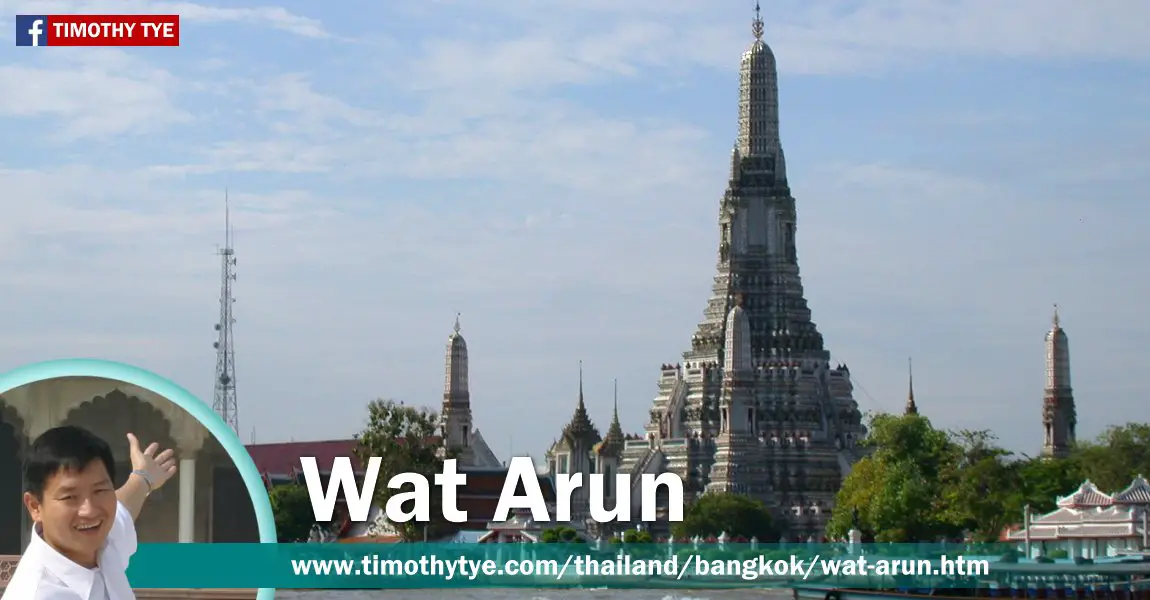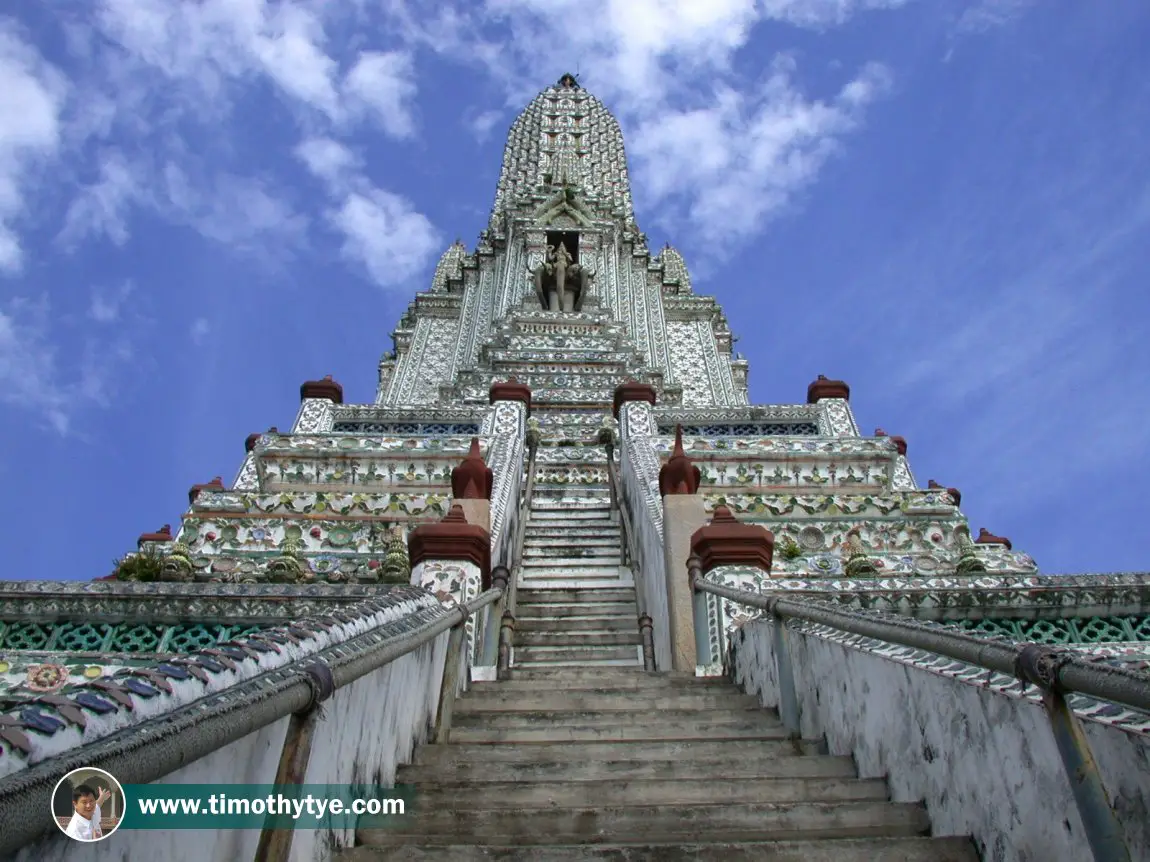
 Wat Arun, Bangkok (30 December, 2002)
Wat Arun, Bangkok (30 December, 2002)
Wat Arun (GPS: 13.7437, 100.48892; Thai: วัดอรุณราชวราราม ราชวรมหาวิหาร
 ) is one of the most important temples in Bangkok. It is often known simply as Wat Arun, and in English as the Temple of Dawn, Wat Arun is located at 34 Arun Amarin Road, in Bangkok Yai, one of the two districts in Thonburi, on the west bank of the Chao Phraya River which gave the English name "Bangkok" to the whole city.
) is one of the most important temples in Bangkok. It is often known simply as Wat Arun, and in English as the Temple of Dawn, Wat Arun is located at 34 Arun Amarin Road, in Bangkok Yai, one of the two districts in Thonburi, on the west bank of the Chao Phraya River which gave the English name "Bangkok" to the whole city.The central prang, or pagoda, of Wat Arun is one of the most iconic symbols of Bangkok, adopted as the crest of the Tourist Authority of Thailand, TAT, as well as on the 10-baht coin. The prang is to be between 66.8 and 68 meters tall. It is surrounded on four sides by smaller prangs, an arrangement that is to represent Mount Meru, the traditional abode of the gods in Hinduism and centre of the cosmos in Buddhism. The architectural style is Ayutthayan, with influences from the Khmer, which in turn bears elements of Hinduism.
Wat Arun is older than Bangkok itself, having been established when the capital was in Ayutthaya. Originally, it was known as Wat Makok, or Olive Temple. When General Phraya Taksin arrived at Thonburi at dawn, he renamed it Wat Chaeng, meaning Bright Temple. It served as his royal chapel and housed the Emerald Buddha until it was moved to Wat Phra Kaeo in 1785. Under the reign of King Rama II, its name was changed to Wat Arun Ratchatharam, after Aruna, a Hindu god of dawn. Finally, under King Rama IV, it got its present name, Wat Arun Ratchawararam.
The main prang and the four smaller prangs are decorated with broken porcelain, bearing influences of Chinese chien-nien (broken-porcelain) art. The porcelain pieces, donated by the locals as a form of merit making, are arranged to form floral patterns though some as simply pasted whole onto the prangs.
In niches at the smaller prangs are statues of Phra Pai, the god of wind, on horseback. Around the base of the prangs are rows of yaksha, "demons" that lend support to the structure. Within the compound of Wat Arun (and as a matter of fact, a few other Buddhist temples in Bangkok), you can find life-style Chinese-style sculptures of warriors or guards. These are actually ballasts used by cargo ships that ply between China and Bangkok, and are now installed at the temples as ornamentations.
The main prang of Wat Arun sit on a square base, with a mondop at each cardinal point, and a smaller (but nonetheless still gigantic) prang at each of its four corners.
 Wat Arun, Bangkok (30 December, 2002)
Wat Arun, Bangkok (30 December, 2002)
 The viharn of Wat Arun, Bangkok (30 December, 2002)
The viharn of Wat Arun, Bangkok (30 December, 2002)
 Inside the viharn of Wat Arun, Bangkok (30 December, 2002)
Inside the viharn of Wat Arun, Bangkok (30 December, 2002)
Wat Arun on Google Street View
Wat Arun (Nov 2012)Getting there
Assuming you are coming from the main part of Bangkok, which is on the east bank of the Chao Phraya river, take a ferry boat across the river from Tha Tian Express Boat Pier located at Thai Wang Road. The ferry operates from 6:00am to 10:00pm daily. The journey across the river takes about 10-15 minutes.Location: Arun Amarin Road
Opening hours: 8:30am to 5:30pm daily
Visiting Wat Arun at night
A few friends joined me as we explored Wat Arun after closing time.Wat Arun is  on the map of Bangkok
on the map of Bangkok
[an error occurred while processing this directive]List of Wats in Bangkok and Wats in Thailand; list of Districts of Bangkok
[an error occurred while processing this directive]About this website

Dear visitor, thank you so much for reading this page. My name is Timothy Tye and my hobby is to find out about places, write about them and share the information with you on this website. I have been writing this site since 5 January 2003. Originally (from 2003 until 2009, the site was called AsiaExplorers. I changed the name to Penang Travel Tips in 2009, even though I describe more than just Penang but everywhere I go (I often need to tell people that "Penang Travel Tips" is not just information about Penang, but information written in Penang), especially places in Malaysia and Singapore, and in all the years since 2003, I have described over 20,000 places.
While I try my best to provide you information as accurate as I can get it to be, I do apologize for any errors and for outdated information which I am unaware. Nevertheless, I hope that what I have described here will be useful to you.
To get to know me better, do follow me on Facebook!
Copyright © 2003-2025 Timothy Tye. All Rights Reserved.

 , Bangkok
, Bangkok Go Back
Go Back